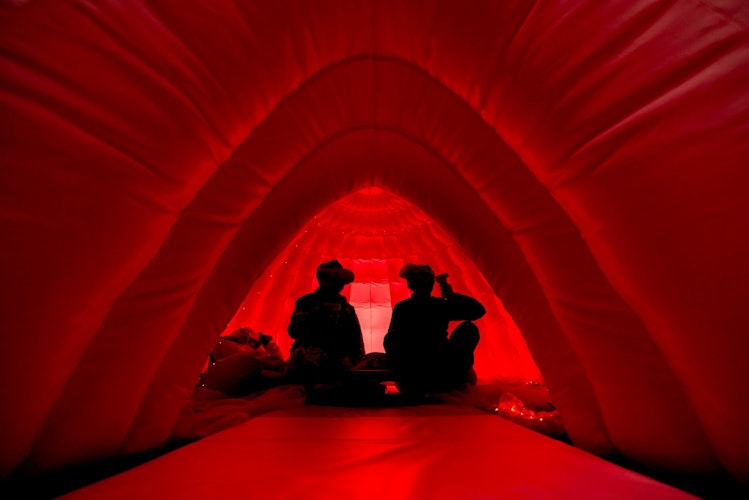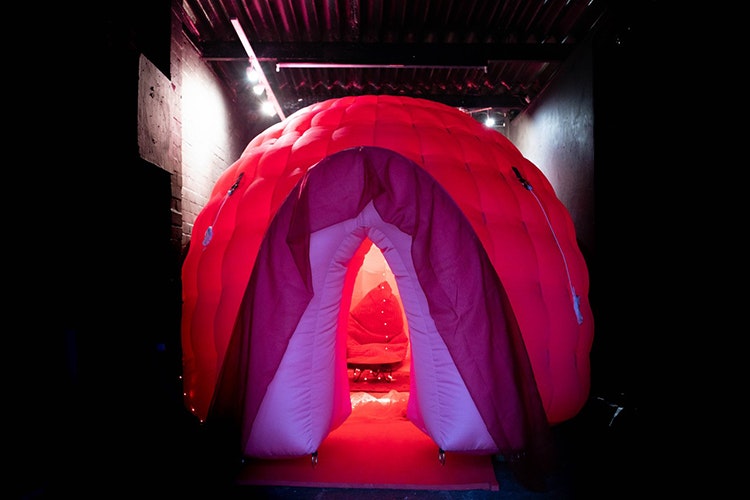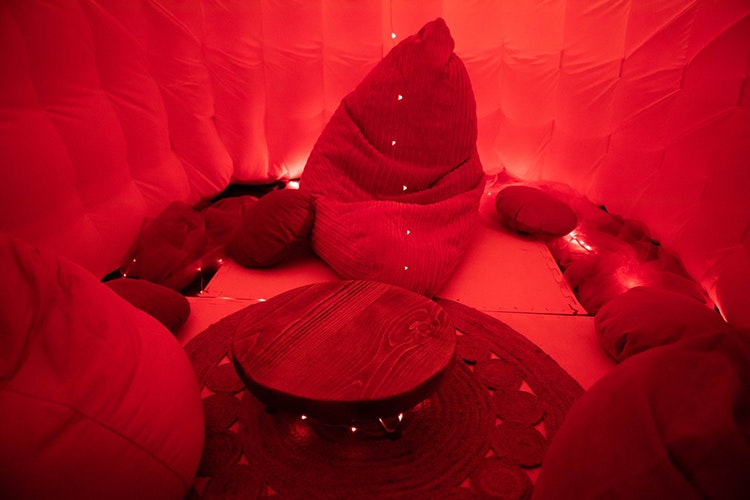For all the supposed leaps forward we’ve made in terms of gender equality, we’ve still got a long way to go when it comes to women’s healthcare: many conditions are woefully under- or mis-diagnosed, and there still remains a baffling sense of taboo in discussing things affecting around half the population, like periods. And in the UK, it’s only as of 2024 that key topics related to women’s health, including menopause, will be included in mandatory assessments for medical students.
Camille Baker – an interdisciplinary digital artist working with immersive experiences, participatory performance, VR design, interactive art, emerging technologies, and digital art curating – wants to platform and open up conversations around such topics through immersive, accessible installations using technologies like VR and haptic garments that respond to the body.
Baker’s piece INTER/her is one such project: billed as an “intimate, artistic immersive exploration of the inner world of women’s bodies and the reproductive diseases they suffer”, it was recently on show at Frequency Festival of Digital Culture in Lincoln and takes the form of an tent-like audio/visual installation and VR experience.

The project was born directly from Baker’s own experience with ovarian cancer around six years ago. “This intense battle gave me the imperative to make something personal through my art practice; to give something back to other women, based upon my own experiences and journey through the healthcare system,” says Baker, who is also a professor of Interactive & Immersive Arts at the RCA.
“The seed grew from silence, inconsistent information and minimal support for women’s health, then became inspired by stories I began to hear from friends and family. Stories that seemed to be hidden or kept secret until I opened up about my own experiences.”
INTER/Her features a number of interviews with women about health issues including menopause symptoms; painful periods; ovarian, cervical, uterine, vaginal, endometrial and peritoneal cancer; endometriosis; fibroids; and more. These recordings, alongside readings from selected feminist literature texts, were edited into a layered 3D audio soundscape with “voices recounting their own unique journeys, gradually building an extremely personal, emotional, and possibly haunting experience,” says Baker.
Shattering the taboo of ‘weird women’s problems’
In making the project, despite speaking about her own experiences Baker was still struggling to find people willing to speak about their experiences in a potentially public forum. To get around this, she hired a voice actor; and in a strange twist, the actor realised she could also, in fact, talk about her own experiences with severe endometriosis. “These things are still considered ‘weird women’s problems’, and a lot of women don’t talk about them,” says Baker.
Baker’s background is in a mixture of web design, interactive and digital arts, and performance. Her focus for the past decade or so has largely been on creating art spaces that engender “one on one, personal intimate experiences that focus on the body as the centre of knowledge and experience and something we need to pay more attention to,” she says.
“My focus is finding ways for people to communicate, but also to feel things through the body and to explore intimate experiences,” she continues. “After my cancer, I wanted to find ways of sparking the sort of conversations I was having in hospital in a way that made people feel comfortable talking about them.”
My focus is finding ways for people to communicate, and to explore intimate experiences
INTER/her uses a bespoke physical dome tent space created from bouncy castle-like materials to form an “inside-out sensory and emotional experience”. Visitors are first fitted with a wearable haptic garment and VR headset (the designers opted to use the Android-based Oculus Quest 2 headset) before crawling through the “vaginal-style” tent opening.
The garment delivers “responsive visceral vibrations” onto the lower abdomen, which are triggered by story objects encountered on the VR narrative journey. At the end of the experience, visitors are debriefed concerning their feelings, given an opportunity to share and record their own story.

Designs informed by “vaginal” artworks, nature, and Paganism
The design of the tent itself was deliberately kept similar to the virtual starting space in terms of furnishings and aesthetics in order to assist orientation. “It’s all meant to be like a womb, but it also has to be a welcoming space, so there’s fairy lights and soft furniture on the inside,” says Baker.
INTER/her interaction designer Maf’j Alvarez created the VR experience using Unity, alongside one of Baker’s students. “We spent days experimenting with environments and materials to see which would work well. We especially played with subsurface scattering – the effect you get when light shines behind a translucent material like a candle or finger in front of a torch, ” Alvarez explains.
“Designing the user experience was also a dimension we experimented with. We had to consider how much agency to give a user, either allowing them to move and turn around freely or heavily guiding them along a path to focus their attention more on the stories.”
The VR journey sees participants move through several connected virtual spaces, which use 360° images to “showcase the many post-reproductive concerns inside the female body,” Baker explains. Imagery depicting “different states of disease or dysfunction” are overlaid with more abstract images, like various flowers that represent different health conditions, or “beautiful, positive aspects promoting the essence of woman,” as Baker puts it. Design influences include so-called “vaginal” artworks, historical goddesses, crones, Pagan and Wicca symbols, flowers and nature.

“There were a lot of tears”
The responses Baker has had to INTER/her have been profound, and powerful. “I had young people come in and say they had no idea about these things, and they say thanks for educating them about their bodies,” says Baker.
The project is promoted through women’s health charities and gynaecologist surgeries, in order to directly reach as many women as possible, and several people from an endometriosis support group came along to the piece at Frequency. “There were a lot of tears and that was an opportunity for me to say ‘okay, take this moment to be in that and discuss it’. We had some really good responses, like ‘thank you for validating this, please get this out there’,” says Baker.
Her challenge in showing the piece more widely is that it sits in a tricky spot between culture, learning, and raising awareness: it isn’t purely an art piece, but neither is there “meant to be an educational dimension in a strict scientific way,” says Baker.
“It’s completely abstract, but at the same time, it’s suggestive of where things are and what things do in the body. More importantly, the idea is that after people have done [the experience] we sit and have a chat about it: how did it make you feel? What did you think about? People generally open up what they, or somebody they know, has experienced.”
She adds, “It’s meant to be more of a conversation starter: it’s about getting people to feel comfortable to talk about these things.”
VR as a tool for self-reflection
It’s interesting to see VR used to do this: as a technology that’s rapidly evolved over the past few years, there’s been much murmuring about its therapeutic potential, and pieces like INTER/her demonstrate just how powerful that can be in the hands of the right designers and artists. Baker suggests that VR works best when moved away from social experiences, and sees its biggest potential in exploring “these kinds of really personal stories”. She continues, “it’s really quite valuable because it gets people to think about themselves – about their own bodies, about what they think or feel.
VR is really, really great for getting people to sit and be in the moment
“It’s not a therapy in the strictest sense, but it offers a kind of permission to feel and reflect. Most of our day is a lot of doing – but there’s not a lot of fueling or sitting with ourselves. It wasn’t totally intentional for me to make health-based projects, it was more about making something that taps into the emotional side of fairly traumatic experiences and unspoken experiences. VR is really, really great for that because it’s getting people to sit and be in that moment. It really gets people to focus.”
When we speak, Baker is in Dundee for her Mammary Mountain project, another VR-based piece that this time focuses on breast cancer. She points out that another reason VR works so well for these sorts of projects is that it’s accessible: “we could take this into cancer support groups or into hospitals. It’s super portable, so we get it into places that wouldn’t necessarily attract the [arts] audience.”

Empowering women digital designers
As for the potential of interactive design in the future in terms of progressing the conversation around women’s health, Baker says a key step will be training more women in digital arts and digital design. “We need to get more women on every level of the design process of these kinds of projects and addressing these topics so that it becomes normal: right now we just have so many men in this space. We have to empower more women in digital art and design to talk about these stories.” she says.
She adds that one of the big challenges for INTER/her has been finding a space to show it, since a lot of the “alternative or ‘cool’ galleries are really focused on external stuff – things like surveillance capitalism, where technology’s going – these big high level things,” Baker explains. “We need to talk about all kinds of things, not just the ‘big’ political issues, but the political issues around equality and the issues that we’re facing on individual levels as well.
The second-wave feminism phrase, ‘the personal is political’, springs to mind. “I think that’s become my new job – to try to open up conversations, and get women to be ok with talking about these things and asking for change,” says Baker. “We need to be more assertive about what we want and what we need… A lot of these topics are either taboo or or they don’t seem important enough: women don’t want to ‘cause a fuss’.”

- Design disciplines in this article
- Industries in this article









